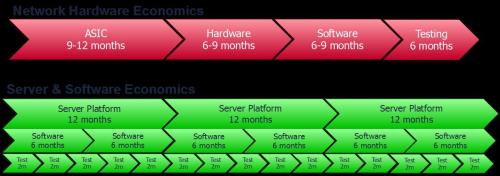Virtualizing the Broadband Edge
Moving to a Virtual Broadband Edge
Most operators have a cloud today, either used to provide internal infrastructure or, in many cases, they have a cloud-based business infrastructure service through organic data center development or acquisition. However, logically, these “clouds” – the network “cloud” and the data center “cloud” – are two different entities. Customers using data center services need to transit the network “cloud", which is managed completely differently. While data center resources are created on the fly using automation from a web portal, network services require manual intervention and are often delayed because of the necessary change control mechanisms of a unique complex infrastructure. By moving the broadband edge functionality into the cloud, operators can connect customers directly to the cloud, bypassing the edge network. Connected to the cloud, the operator can choose to virtualize other network capabilities and market the combined network/cloud services from a single infrastructure – migrating network services to the same web portal operating and transactional environment used to deliver infrastructure services.

[Software Server Economics Source:Active Broadband Networks 2015]
To achieve this first migration step and unlock the cloud for delivering combined connectivity, network, infrastructure and application services, the edge complex – consisting of broadband network gateways and OSS software – needs to be moved to software, then virtualized and managed by cloud automation software. This is long overdue. Today’s OSS and BNG technologies are archaic relics that evolved from their initial beginnings at the dawn of the Internet age in the 1990s. Initially, OSS consisted of an authorization, activation and accounting server. However, over time, many other functions have been gradually added to this infrastructure as separate components from different vendors. Virtualizing each of these individual components is impractical, so a new architecture of controllers and orchestration is emerging to replace the OSS complex.
Similarly, BNGs have become the most complex and costly packet-processing components in the network, which can be explained by examining the two primary functions they provide. A BNG provides customer access, which is programmed from a customer’s service entitlement, and network-network connectivity, which is programmed by routing protocols. It’s the combination of these two capabilities and the use of BNGs to provide network services and connectivity between networks in a single platform that drives both cost and complexity.
While the consolidation of functionality into BNGs was the best solution in the last generation of networks, a separation of functionality is a superior solution in the current webscale generation. By separating access and routing into logical functions, the efficiencies of routing for network-network connectivity can be retained in both the virtual and physical network, while the complexity of edge access can be reduced. This reduction in complexity unlocks the opportunity for greater product and service innovation. These innovations can be delivered in the form of new dynamic connectivity service functionality and new virtual network services. But perhaps more important is the ability to apply these innovations. In the last generation of edge BNG technology, all services were consolidated on a single edge platform, which has become one of the most significant barriers to new service experimentation and introduction. For example, when a new service is being planned for introduction, the time to develop and test for that service is dominated by the need to ensure that the existing revenue-generating services are not disrupted, not by the time that it takes to design and verify the new functionality. By virtualizing and refactoring virtual functions, new service experimentation and introduction can be undertaken without any impact to existing services – unlocking revenue potential and freeing engineers from managing boutique network equipment to focus on new service development. In this way, a new generation of network services will emerge.
It begins by moving the edge complex into an Openstack cloud and examining the distribution of functionality. Virtualization can enable operators to re-create the same network architecture more effectively, and, more importantly, provide the freedom from them to re-imagine the network architecture virtually and rapidly implement changes for the benefit of their customers.



















